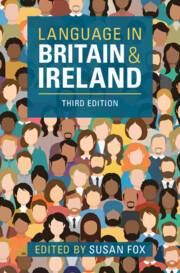Book contents
- Language in Britain and Ireland
- Language in Britain and Ireland
- Copyright page
- Contents
- Figures
- Tables
- Contributors
- Acknowledgements
- Map of Britain and Ireland
- Introduction
- Part I English
- 1 The History of English
- 2 Standard and Non-standard English
- 3 Phonetic and Phonological Variation in England
- 4 Grammatical Variation in England
- 5 Discourse-Pragmatic Variation in England
- 6 Scots and Scottish Standard English
- 7 English in Ireland
- 8 English in Wales
- 9 Insular Varieties of English in Britain
- 9 Insular Varieties of English in Britain
- 9 Insular Varieties of English in Britain
- 9 Insular Varieties of English in Britain
- Part II Multilingualism in Britain and Ireland: The Celtic Languages
- Part III Multilingualism in Britain and Ireland: Minority Languages
- Part IV Multilingualism: The Development of Urban Contact Varieties
- Part V Applied Sociolinguistic Issues
- Index
- References
7 - English in Ireland
from Part I - English
Published online by Cambridge University Press: 17 October 2024
- Language in Britain and Ireland
- Language in Britain and Ireland
- Copyright page
- Contents
- Figures
- Tables
- Contributors
- Acknowledgements
- Map of Britain and Ireland
- Introduction
- Part I English
- 1 The History of English
- 2 Standard and Non-standard English
- 3 Phonetic and Phonological Variation in England
- 4 Grammatical Variation in England
- 5 Discourse-Pragmatic Variation in England
- 6 Scots and Scottish Standard English
- 7 English in Ireland
- 8 English in Wales
- 9 Insular Varieties of English in Britain
- 9 Insular Varieties of English in Britain
- 9 Insular Varieties of English in Britain
- 9 Insular Varieties of English in Britain
- Part II Multilingualism in Britain and Ireland: The Celtic Languages
- Part III Multilingualism in Britain and Ireland: Minority Languages
- Part IV Multilingualism: The Development of Urban Contact Varieties
- Part V Applied Sociolinguistic Issues
- Index
- References
Summary
This chapter begins by surveying the linguistic history of Ireland. Although it is situated on the periphery of the British Isles, there is evidence of contact between the island, other regions of Britain and indeed other countries in western Europe for centuries. It explores early and later contacts between the indigenised Celts and more recent colonisers and immigrants, including the Normans, the English, the Scots and twentieth-century settlers from the European Union prior to Brexit. These contacts have created a set of contemporary Irish English varieties that are not only distinctive with respect to other world Englishes but are also differentiated diatopically, ethnically and socially. Two main topics are addressed. The degree to which Irish English from different time frames is structurally similar to other dialects spoken elsewhere is considered alongside evaluating the extent to which contemporary Irish Englishes vary internally and externally with respect to their lexis, phonology, morphosyntax and discourse pragmatics. Some space is also devoted to examining how the study of Irish English has developed and what directions research might take in the twenty-first century in response to new approaches to modelling linguistic contact as well as the availability of larger and more diverse digital datasets.
Keywords
- Type
- Chapter
- Information
- Language in Britain and Ireland , pp. 178 - 207Publisher: Cambridge University PressPrint publication year: 2024

